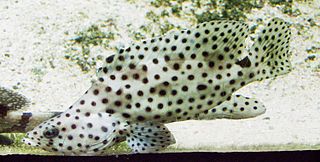
Serranidae is a large family of fishes belonging to the order Perciformes. The family contains about 450 species in 65 genera, including the sea basses and the groupers. Although many species are small, in some cases less than 10 cm (3.9 in), the giant grouper is one of the largest bony fishes in the world, growing to 2.7 m in length and 400 kg (880 lb) in weight. Representatives of this group live in tropical and subtropical seas worldwide.

The leafscale gulper shark is a dogfish of the family Centrophoridae. C. squamosus is reported to have a lifespan of approximately 70 years, based on otolith ring counts. It was the first described species in the genus Centrophorus, which now contains 13 species.
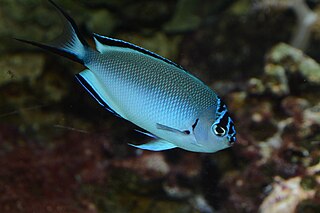
Genicanthus watanabei, the blackedged angelfish or Watanabe’s angelfish, is a species of marine ray-finned fish, a marine angelfish belonging to the family Pomacanthidae. It is found in the Pacific Ocean.
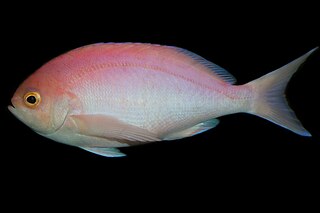
The pink maomao, also known as the longfin perch, is a species of marine ray-finned fish, a member of the family Anthiadidae. It is found in the southern Pacific and the southeastern Indian Ocean.
The Japanese snapper is a species of marine ray-finned fish, a snapper belonging to the family Lutjanidae. It is native to the Western Pacific Ocean.

The blacktip grouper, also known as the redbanded grouper, blacktipped cod, black-tipped rockcod, footballer cod, red-barred cod, red-barred rockcod, scarlet rock-cod or weathered rock-cod, is a species of marine ray-finned fish, a grouper from the subfamily Epinephelinae which is part of the family Serranidae, which also includes the anthias and sea basses. It is found in the tropical Indo-Pacific region. It is the type species of the genus Epinephelus.

The large-scale whiting the only member of the genus Sillaginops, is a poorly understood species of coastal marine fish of the smelt- whiting family Sillaginidae. First described in 1859, the large-scale whiting is known to inhabit shallow waters along the coasts of a number of Indo-Pacific countries including Japan, Indonesia, Philippines and the Solomon Islands. Little is known of the species biology, even though it is of minor importance to fisheries throughout its range.
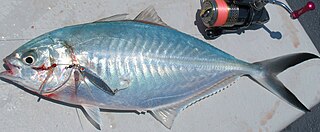
The herring scad, is a common species of tropical marine fish in the jack family Carangidae. The species inhabits the surface waters of coastal regions throughout the Indo-West Pacific region, feeding on a variety of crustaceans and small fishes. It is the largest fish of the scad genus Alepes, growing to a recorded length of 56 cm. The herring scad is identified among the genus Alepes by its more numerous and smaller scutes and the number of gill rakers on the first arch. It is of minor importance to fisheries throughout its range.

The yellowtail scad, is an abundant species of small inshore marine fish of the jack family, Carangidae. The species is widespread in the Indo-Pacific region from east Africa in the west to Hawaii in the east, extending north to Japan and south to Australia. The yellowtail scad is the only member of the monotypic genus Atule and is distinguished from similar species by a well-developed adipose eyelid and finlet-like extensions of the last rays of the dorsal and anal fins. It inhabits coastal areas such as bays and coral reefs, preying on small fishes and crustaceans. Spawning has been well studied in Hawaii, where fish enter bays to spawn, releasing up to 161,000 eggs each between March and October. The yellowtail scad is an important component of fisheries throughout its range, taken by a number of netting and hook-and-line methods. It is a prized food fish in some regions and is cooked or preserved by a variety of methods.

The shadow trevally, also known as the shadow kingfish, twothread trevally or Aldabra trevally, is a species of inshore marine fish in the jack family Carangidae. The species is patchily distributed throughout the tropical and subtropical waters of the Indian and west Pacific Oceans, from South Africa in the west to Japan and Samoa in the east, reaching as far south as Indonesia and New Caledonia. It is most easily distinguished from similar species by as series of dark rectangular blotches under the second dorsal fin, giving a 'shadowed' appearance, from which its common name is derived. The shadow trevally is a reasonably large fish, growing to 85 cm in length and at least 2.6 kg in weight. It inhabits shallow coastal waters, including reefs, bays, and estuaries, where it takes small fish and benthic crustaceans as prey. Nothing is known of the species' ecology and reproductive biology. It is of little importance to fisheries, and is occasionally taken by bottom trawls and other artisanal fishing gear.

The golden grouper, also known as the pink grouper or Powell's grouper, is a species of marine ray-finned fish, a grouper from the subfamily Epinephelinae which is part of the family Serranidae, which also includes the anthias and sea basses. It is found in the eastern Indian Ocean and Western Pacific Ocean.

Polydactylus sexfilis, the six-finger threadfin or yellowthread threadfin, is a species of marine ray-finned fish, a threadfin from the family Polynemidae which is found in the Indian and Pacific Oceans.
The painted swellshark is a little-known species of catshark, belonging to the family Scyliorhinidae, found in eastern Indonesia. This species reaches a maximum known length of 72 cm (28 in), and has a thick body with a short, broad and flattened head. It is dark gray with a variegated pattern of irregular darker and lighter blotches above, and lighter below with gray blotches and speckling on the snout. Like other swellsharks, it can inflate itself as a defensive measure.
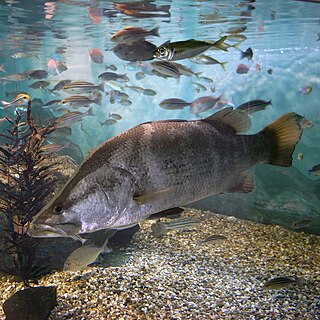
The Japanese lates, also known as the akame or Japanese barramundi, is a species of fish found in Japan. A bottom-dweller restricted to estuarine habitats and large rivers in the Pacific coastal western parts of the country, it is threatened by habitat destruction. As it is similar to the related barramundi, it was classified as the same species until 1984.

The Indonesian angelshark is a rare species of angelshark, family Squatinidae, known only from a few specimens collected from fish landing sites in southern Indonesia. It is thought to inhabit the deep waters of the continental slope. Reaching at least 1.34 m (4.4 ft) long, this species has a flattened, ray-like shape and a well-developed tail and caudal fin. It is characterized by the absences of fringes on its nasal barbels and thorns down the midline of its back, as well as by its relatively plain grayish-brown dorsal coloration with dark saddles beneath the dorsal fin bases and a black leading margin on the underside of the pectoral fins. The International Union for Conservation of Nature (IUCN) has classified it as Critically Endangered due to significant fishing pressure.

Rypticus is a genus of marine ray-finned fish, related to the groupers and classified within the subfamily Epinephelinae of the family Serranidae. It is one of several genera of soapfishes. These fish live in the Atlantic and eastern Pacific Oceans in tropical and warmer temperate zones.

Lepidoperca is a small genus of ray-finned fish belonging to the family Anthiadidae. It includes ten species.
Squalus montalbani, the Philippine spurdog or Indonesian greeneye spurdog, is a relatively large species of dogfish shark native to waters off the coast of Australia, the Philippines, and Indonesia. The species was identified in 1912 from a specimen caught off the coast of Luzon Island, and has been both bycatch and a targeted species in fisheries since. Its taxonomy is complex, having been renamed in 1931, being misidentified as a type of shortspine spurdog, then being revived as a species in 2007.

Nemanthias is a genus of marine ray-finned fish in the family Anthiadidae. It is a monotypic genus containing the single species Nemanthias carberryi, the threadfin anthias, which is native to the western Indian Ocean. It is found at depths of 10–30 meters on coral reefs.

Cephalopholis igarashiensis, known as the garish hind, Neptune grouper, goldbar grouper, or Japanese cod, is a deepwater species of marine ray-finned fish, a grouper from the subfamily Epinephelinae which is in the family Serranidae which also includes the anthias and sea basses. It is found on coral reefs at depths of 80 to 250 m in the Indo-Pacific.















